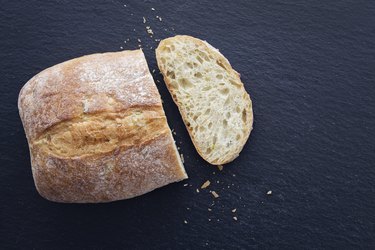
Tinea versicolor is a fungal infection of the skin, which interferes with normal skin pigmentation, resulting in small, discolored patches. What constitutes good nutrition for tinea versicolor? There's not a specific tinea versicolor diet, but eating well in general is helpful.
The American Academy of Dermatology says tinea versicolor (also known as pityriasis versicolor) is caused by a yeast species known as Malassezia. This yeast is found on everybody's skin. A number of factors can trigger the yeast to overgrow, including having oily skin, living in a hot and humid climate and sweating a lot.
Video of the Day
Video of the Day
Immune-Strengthening Tinea Versicolor Diet
The American Academy of Dermatology adds that a weakened immune system contributes to tinea versicolor, so a diet that builds up your immune system could also be useful.
According to Harvard Health, shortages of zinc, selenium, iron, copper, folic acid, as well as as vitamins A, B6, C and E alter immune responses in test tube and animal studies. While human research is lacking, it's a good bet that a diet with lots of vegetables, fruit, lean protein and whole grains like whole wheat will help to prevent these nutrient deficiencies and keep your immune system healthy, which in turn may help protect against tinea versicolor.
Foods to avoid with tinea versicolor, or at least to cut down on, include sugary and highly refined carbohydrates like candies, white bread, cookies and potato and maize-based savory snacks. The American Academy of Dermatology says these foods have a high GIycemic Index (GI), causing blood sugar spikes that can promote inflammation and cause your skin to make more oil. Excess oil production by the skin is linked with both acne and tinea versicolor.
Candida Albicans Link?
A review in the November 2014 issue of American Family Physician lists Candida yeast as separate from the Malassezia type. However, the two can sometimes cause similar symptoms, as reported in the April 2014 issue of Journal of Correctional Health Care.
Some people suggest that an "anti-Candida" diet should be adopted for any sort of fungal infection, which would mean cutting out yeast and cheese in addition to sugar, based on the theory that these foods promote yeast overgrowth. But the Mayo Clinic is skeptical, explaining that if such a diet does help, it's probably just because you are thinking about what you eat a bit more and improving the quality of your diet overall.
Garlic and Probiotics
Eating yogurt for tinea versicolor is a common thing to do, and it certainly can't hurt, as natural yogurt is a known probiotic food (or food that contains friendly bacteria). A small February 2017 study in Beneficial Microbes found that dandruff, which also involves overgrowth of Malassezia yeast, improved when 60 people with flaky scalps were given Lactobacillus paracasei, which is a bacterium found in some probiotic yogurts.
Read more: How Vitamins Can Help Protect You From Skin Fungus
As for garlic, there's no evidence that it needs to be part of a tinea versicolor diet. Though there is overall a great deal of research that has been done on garlic, the National Center for Complementary and Integrative Health says much of it consists of small, preliminary or low-quality studies.
One thing you should not be tempted to do, despite some people promoting the idea, is to put raw garlic in contact with the skin. A case report in a July 2018 issue of the British Medical Journal reported nasty skin burns sustained by a woman who applied raw garlic to her foot.
- American Academy of Dermatology: "Tinea Versicolor"
- Harvard Health Publishing: "How to Boost Your Immune System"
- American Academy of Dermatology: "Can The Right Diet Get Rid of Acne?"
- American Family Physician: "Diagnosis and Management of Tinea Infections"
- Journal of Correctional Health Care: "An Outbreak of Candida Albicans Folliculitis Masquerading as Malassezia Folliculitis in a Prison Population"
- Mayo Clinic: "What Is a Candida Cleanse Diet and What Does It Do?"
- Beneficial Microbes: "The Positive Benefit of Lactobacillus Paracasei NCC2461 ST11 in Healthy Volunteers With Moderate to Severe Dandruff"
- National Center for Complementary and Integrative Health: "Garlic"
- British Medical Journal: "A Garlic Burn"
- American Academy of Dermatology: "Tinea Versicolor"
- Harvard Medical School: "How to Boost Your Immune System"
- American Academy of Dermatology: "Can The Right Diet get rid of Acne?"
- American Family Physician: "Diagnosis and Management of Tinea Infections"
- Journal of Correctional Health Care: "An Outbreak of Candida Albicans Folliculitis Masquerading as Malassezia Folliculitis in a Prison Population"
- Mayo Clinic: "What Is a Candida Cleanse Diet and What Does it Do?"
- Beneficial Microbes: "The Positive Benefit of Lactobacillus Paracasei NCC2461 ST11 in Healthy Volunteers With Moderate to Severe Dandruff"
- National Center for Complementary and Integrative Health: "Garlic"
- British Medical Journal: "A Garlic Burn"